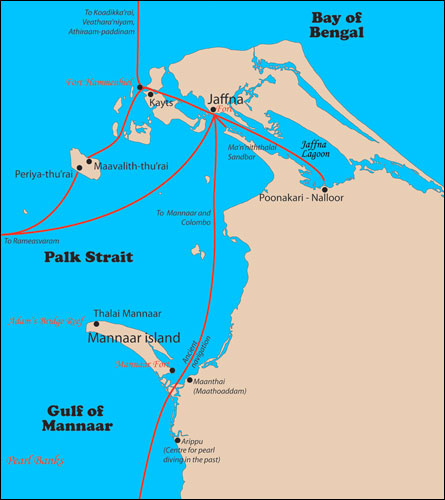Pottery associated with Roman times of the early historic period were found in the premises of the King’s House in Jaffna fort by archaeologists of the University of Jaffna led by Prof P. Pushparatnam. The team took over digging after getting information on pottery finds when a pit was dug for toilet purposes in the King’s House premises. The disturbed rubble layer at the top had a variety of pottery of various periods, including Rouletted Ware and Amphora Ware associated with Roman times. Digging further, the Jaffna University team reached a floor level and artefacts are being excavated even below that level. From the indications at the surface, the excavators expect to reach undisturbed levels of early historic habitation in the excavation.
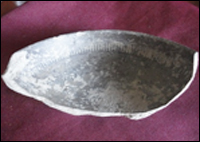
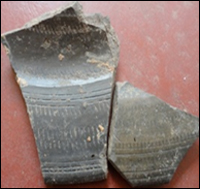
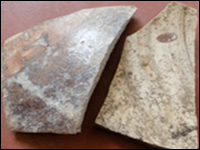
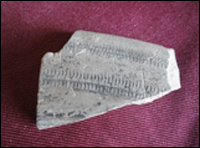
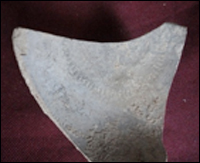
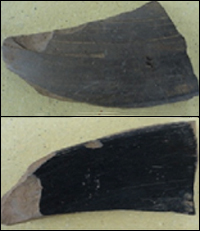
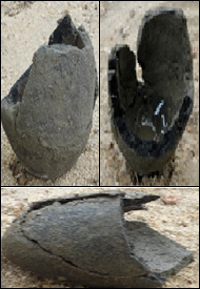
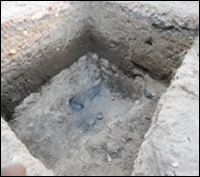
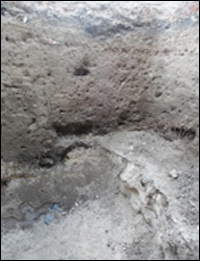 Rouletted Ware, a pottery of grey earth with black or red polish, having a typical potter’s mark made by an apparatus of the potter’s wheel, was an imported pottery associated with Greacco-Roman trade with South Asia. There were also imitations made probably in Bengal. The time range of the ware is between c. 2nd century BCE and c. 4th century CE.
Rouletted Ware, a pottery of grey earth with black or red polish, having a typical potter’s mark made by an apparatus of the potter’s wheel, was an imported pottery associated with Greacco-Roman trade with South Asia. There were also imitations made probably in Bengal. The time range of the ware is between c. 2nd century BCE and c. 4th century CE.
Amphora jars of the Roman wine trade that have a tapering bottom are also artefacts of the same period.
The discovery of both the types of pottery in the disturbed layers of the Jaffna fort indicates that an early historic port city existed at the locality where the fort stands now.
Jaffna was known in pre-Portuguese Tamil inscriptions and literature as Yaazhppaa’naayan-paddinam or I-aazhppaa’naayan-paddinam. The suffix Paddinam indicates that it was a port-city even before the Portuguese building a fort there in 1560 CE. The fort was re-built by the Dutch in 1680 CE.
The importance of the port city probably made the European colonial rulers to build the fort and to make it the capital for the territories of the Tamil kingdom they conquered in the north.
Systematic excavations both extensive and deep enough inside the fort will sure reveal the pre-colonial port-city and its early historic origins, academics in Jaffna said.
The Jaffna university excavators have already reached the water table, but artefacts are found even below that. Water has to be pumped out to go further deep, the excavators said.
Artefacts associated with Roman trade are extensively found at Kantharodai in the heart of Jaffna peninsula. Some years back, hundreds of Roman coins have been found in a hoard in a site at Varani. The megalithic burial site of Anaikkoaddai is just a couple of km away from the Jaffna fort. Chaaddi, Allaippiddi and Ma’n’niththalai, where early pottery has been found are just off the Jaffna city, located at its lagoon entrance.
Even earlier, there were reports of finding Roman coins in the Jaffna fort.
Informed circles in Jaffna said that last year too Colombo’s archaeology department had dug a trench at a ground inside the fort and had found many artefacts. But details are not known.
Colombo’s archaeology in the Tamil country habitually takes the excavated material to Colombo. Reports do not come. Evidences often go ‘missing’.
The material excavated in Maanthai are in Anuradhapura and Colombo. A report is now said to be coming after 30 years. A full report of the Kantaroadai excavations of 1967 that brought to light the megalithic heritage and early urban heritage of Jaffna is still awaited.
More than academic investigation and dissemination of knowledge, importance is given only to political archaeology such as building Buddhist stupas. Alienating Tamils from their land and their heritage was always the motive behind the archaeological projection of Colombo. The archaeology department of Colombo doesn’t have any Tamil academics or officials, point out Eezham Tamil academics.
The Jaffna fort project is now funded by the Dutch government and is being carried out by the SL archaeology department. Already there is much resentment in Jaffna over the priority given to the archaeology and renovation of the fort, while people are uprooted and are living in open prisons under an occupying military.
Heritage studies of a land are a prerogative of free people of that land. Otherwise it will continue to be ‘colonial’.
But heritage is business to corporate colonialism and is politics to its local partners.
Whether because of pressure from the Dutch government or to make a show to the outside world, for the first time in decades, a Jaffna university team is allowed to participate in archaeological work, academic circles in Jaffna commented.
Work has been stopped at an earlier trench near the entrance to the fort where a skeleton has been found in the disturbed layers.
The present trench Near the King’s House is in the central part of the fort.
Professor Paramu Pushparatnam, Head of the Department of History of the University of Jaffna, did his Ph.D. in Archaeology at the Tamil University of Tanjavur under Professor Y. Subbarayalu. Much earlier, as a student of the University of Jaffna, he participated the excavation of Aanaikkoaddai in 1980 and the excavation of Maanthai in the early 1980s.
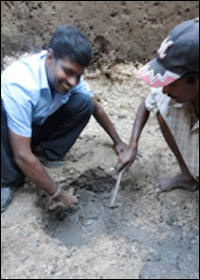
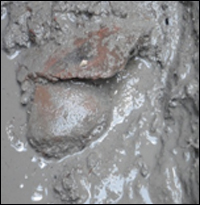
Related Articles:
01.08.08 Jaffna/
Yaazhppaa'nam/
Yaazhppaa'nap Paddinam/
Ya..






Pieces of Rouletted Ware

Amphora jars

The trench in progress

The layer below a floor level
Amphora jars of the Roman wine trade that have a tapering bottom are also artefacts of the same period.
The discovery of both the types of pottery in the disturbed layers of the Jaffna fort indicates that an early historic port city existed at the locality where the fort stands now.
Jaffna was known in pre-Portuguese Tamil inscriptions and literature as Yaazhppaa’naayan-paddinam or I-aazhppaa’naayan-paddinam. The suffix Paddinam indicates that it was a port-city even before the Portuguese building a fort there in 1560 CE. The fort was re-built by the Dutch in 1680 CE.
The importance of the port city probably made the European colonial rulers to build the fort and to make it the capital for the territories of the Tamil kingdom they conquered in the north.
Systematic excavations both extensive and deep enough inside the fort will sure reveal the pre-colonial port-city and its early historic origins, academics in Jaffna said.
The Jaffna university excavators have already reached the water table, but artefacts are found even below that. Water has to be pumped out to go further deep, the excavators said.
Artefacts associated with Roman trade are extensively found at Kantharodai in the heart of Jaffna peninsula. Some years back, hundreds of Roman coins have been found in a hoard in a site at Varani. The megalithic burial site of Anaikkoaddai is just a couple of km away from the Jaffna fort. Chaaddi, Allaippiddi and Ma’n’niththalai, where early pottery has been found are just off the Jaffna city, located at its lagoon entrance.
Even earlier, there were reports of finding Roman coins in the Jaffna fort.
Informed circles in Jaffna said that last year too Colombo’s archaeology department had dug a trench at a ground inside the fort and had found many artefacts. But details are not known.
Colombo’s archaeology in the Tamil country habitually takes the excavated material to Colombo. Reports do not come. Evidences often go ‘missing’.
The material excavated in Maanthai are in Anuradhapura and Colombo. A report is now said to be coming after 30 years. A full report of the Kantaroadai excavations of 1967 that brought to light the megalithic heritage and early urban heritage of Jaffna is still awaited.
More than academic investigation and dissemination of knowledge, importance is given only to political archaeology such as building Buddhist stupas. Alienating Tamils from their land and their heritage was always the motive behind the archaeological projection of Colombo. The archaeology department of Colombo doesn’t have any Tamil academics or officials, point out Eezham Tamil academics.
The Jaffna fort project is now funded by the Dutch government and is being carried out by the SL archaeology department. Already there is much resentment in Jaffna over the priority given to the archaeology and renovation of the fort, while people are uprooted and are living in open prisons under an occupying military.
Heritage studies of a land are a prerogative of free people of that land. Otherwise it will continue to be ‘colonial’.
But heritage is business to corporate colonialism and is politics to its local partners.
Whether because of pressure from the Dutch government or to make a show to the outside world, for the first time in decades, a Jaffna university team is allowed to participate in archaeological work, academic circles in Jaffna commented.
Work has been stopped at an earlier trench near the entrance to the fort where a skeleton has been found in the disturbed layers.
The present trench Near the King’s House is in the central part of the fort.
Professor Paramu Pushparatnam, Head of the Department of History of the University of Jaffna, did his Ph.D. in Archaeology at the Tamil University of Tanjavur under Professor Y. Subbarayalu. Much earlier, as a student of the University of Jaffna, he participated the excavation of Aanaikkoaddai in 1980 and the excavation of Maanthai in the early 1980s.

Water table reached in the trench

Pottery below the water table
Related Articles:
01.08.08 Jaffna/
Yaazhppaa'nam/
Yaazhppaa'nap Paddinam/
Ya..

